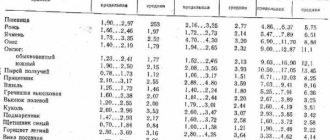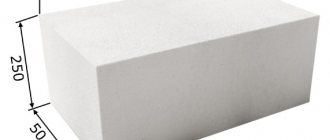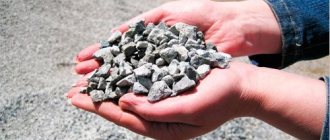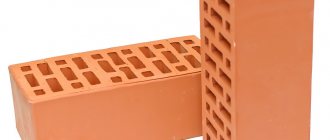Quite often, when performing repair procedures, it becomes necessary to convert the volume of paint and varnish products into weight or vice versa. Often, such information is used to convert the composition used into other volumes, for example, if the paint is in a container with a non-standard rating or tank. But not many newcomers to the construction trade know how to convert kilograms to liters or vice versa. This article will look at how many liters of paint are contained in 1 kg, depending on the type of paint mixture.
What is the displacement of one cubic meter of water
Before you find out how much 1 cubic meter of water weighs, you need to clearly understand its quantitative expression in liters. From this we will make a translation into the mass of interest to us. So how many liters are contained in a cube of water?
The "Cube of Water" fountain shows what a cube of liquid would look like
To give an answer, we need to remember distant physics and mathematics lessons, in which teachers tried to put the necessary information into our heads - one cube is equal to 1000 liters.
Are you trying to imagine how much this is to save on annoying utility bills? Let's try to translate such an abstract quantity into more understandable measures:
- 100 aluminum standard buckets;
- 15 washes in an automatic washing machine with a five-kilogram load;
- Take 30 quick morning showers;
- 115 toilet flushes;
- take a bath 14 times;
- Drink 4000 cups of liquid.
Want to save money? Don’t focus on how many cubic meters you spend monthly, but think about how much water flows away just like that, for example, when you take a break from washing the dishes to turn off the kettle or when brushing your teeth. Just imagine how many liters can leak through a leaking toilet flank. Such unnoticeable mistakes gradually turn into several m3 of water. And if you translate this into money, do you feel like your hard-earned money just evaporates? Well, okay, we've digressed a bit, now let's get back to the main question.
How to determine how much one liter of water weighs?
To conduct such an experiment, we will need a glass or plastic jar, measuring cups, electronic scales and distilled water. First you need to determine the mass of the can using a scale and write down the resulting figure. Pour a liter of water into a measuring cup, pour it into a jar and weigh again. Now you need to subtract the mass of the can - the result will be approximately one kilogram. Such scales can be used to determine the mass of other liquids, such as milk.
If you want to get a more accurate indicator, you need to comply with the conditions of temperature (4˚C) and pressure (760 mm Hg). Then the mass of water will be 998.5 g.
Tap water will show slightly different results when weighed than distilled water. The fact is that tap water may contain impurities of heavy metals, which increases the mass of one liter of water. To calculate the mass of 1 liter of water, special formulas are also used.
Now we know how much 1 liter of water weighs, what factors influence the weight of a liter of water and how to calculate the mass of water experimentally.
The density of paint and varnish materials (paint and varnish materials) for walls, floors, and ceilings is much higher than this water indicator. That is why a kilogram jar may be smaller in appearance than a similar package of aqueous solutions. How to find out how much 1 liter of paint weighs? Such data may be required when planning repairs and calculating the cost of materials. There are special formulas for calculus.
What is the weight of a cubic meter of water
The weight of 1 liter is usually taken as 1 kilogram, therefore, 1 cubic meter of water fits in one ton. But this is not entirely true. In fact, weight is influenced by many factors: pressure, temperature, the state of aggregation in which it is located. Therefore, a ton of water does not always contain 1000 kilograms.
| Weight measure | Liquid state | Solid state (ice from distilled liquid) | Solid state (pure snow) |
| Glass (250 ml), g | 249,6 | 229 | 12,5-112,5 |
| 1 liter, g | 298,2 | 917 | 50-450 |
| Twelve liter bucket, kg | 11,98 | 11 | 5-15 |
| Cubometer, kg | 998,2 | 917 | 100-450 |
The weight of snow directly depends on its density, which is influenced by the area in which the precipitation occurred and the time that has passed since the snowfall. The density of newly fallen snow is 0.05 gp/cm3 and compacted snow is 0.45 gp/cm3.
Even the force of gravity in different parts of the Earth and on different planets affects the weight of a liquid. For example, on Mars, a liter of water weighs 377 grams, therefore, 1 cubic meter is equal to 377 kg.
But let's not fly far and return to our earthly reality. As for the states of aggregation, in each of them it will have a different weight.
Measuring utensils
And where solid substances are measured in liters, bulk substances also appear. Moreover, in the old days it was granular substances that determined the volume of dishes; wheat served as the standard for this. And in the modern world, measuring utensils come to the aid of all housewives. With its help, you can calmly answer the question of how many kilograms are in 1 liter, and not at all of water. After all, everything is clear with water. Depending on the need, measuring utensils can measure how much cream, milk, perhaps even flour or cereal is in one liter. Or perhaps not in one liter, but only in a glass. The measuring cup will show how many kilograms, pounds or ounces are in 1 liter, depending on which country's recipe will be prepared at the moment. If you don’t have measuring utensils at hand, reference books will help, which will tell you, to the nearest gram, the capacity of one liter for all kinds of products.
Effect of impurities and temperature on water weight
From a physics point of view, the specific gravity of the liquid is also important. The amount of the substance of interest that is placed in a volume (in 1 of its units) or, if translated into a scientific term - the mass of a unit of volume - is volumetric density or, to put it differently, specific gravity. This value is measured in kg/m3 or tn/m3 or gp/cm3.
The table below clearly demonstrates the direct effect of temperature and organic impurities on weight. Thus, one cube of liquid in different states contains unequal specific gravity. The data was taken from the reference book of physical properties and materials.
| Name | Number of tons in 1 cube – mass of 1 m 3, t/m 3 | Number of kilograms in 1 m 3 – mass of 1 m 3, kg/m 3 | Specific gravity, gp/cm 3 |
| Water at room temperature at normal atmospheric pressure, m3 | 1 | 1000 | 1 |
| Hot water at normal atmospheric pressure, m3 | 0,98324 | 983,24 | 0,98324 |
| Sea water, m 3 | 1,02 | 1020 | 1,02 |
| Water at a temperature of 0 °C at normal atmospheric pressure, m 3 | 0,999 | 999 | 0.999 |
Now you know the true weight of water in different states and under different conditions. And after some simple calculations, you can convert it into the required units of measurement.
One of the features of building materials is related to the presence of porous areas. They complicate the measurement of specific gravity because it is necessary to weigh an element of ideal density to obtain accurate information. This means that the concrete sample would have to be crushed. It is technically difficult to perform this, and it is necessary during serious examinations. And yet, what is the specific gravity of concrete m200?
Weight of different compounds
It should be remembered that the measurements taken may be inaccurate, because sometimes the density varies by a fraction of a percent. But the error rarely exceeds 5%, which is insignificant for domestic purposes. Laboratories that require precise calculations carry out their density measurements using special equipment. This allows you to obtain results with virtually no error.
Below is a table of the densities of individual types of paints. The limits of permissible values are indicated, which vary from one manufacturer to another:
Calculating the weight of paint can provide useful information.
To carry out the calculations, you just need to read the attached data or find them on the manufacturer’s website.
This article is devoted to the most common, unique, and well-known substance - water. It is difficult to meet a person who does not know the simplest chemical formula of H 2 O. What can be simpler? But is it so simple, this ubiquitous and familiar water? Alas, this is far from the case.
No matter how pragmatic the words of the famous scientist Einstein may sound: “What can a fish know about the water in which it swims all its life?” — it’s hard not to perceive them as a stone in your garden. And the statements of the leading men of the scientific world that in our existence nothing happens by chance, and there is an intelligent design in everything, sound absolutely resonant.
You say: nonsense? We are sure that when considering any new development of IT technologies, the first thought that comes to your mind is the person who created it.
But let’s not argue about high matters and return to pressing issues. How often in everyday life do we ask ourselves the question: how much does a liter of water weigh? For some, this question may seem trivial, and the answer, which lies in the plane of basic knowledge of physics, may seem elementary.
But this is only due to a superficial perception of the essence of the issue. It is impossible not to accept the fact that in different periods of human existence the unit of measurement of the weight of a substance constantly changed its true value.
Some historical data:
- In 1793, a new unit of measurement was first adopted in France - the liter, equal to one cubic decimeter;
- In 1879, the International Committee of Weights and Measures decided and equated one liter to one cubic decimeter;
- In 1901, a liter of water was equivalent to 1 kilogram of water at a temperature of +3.98 o C and a pressure of one atmosphere. In volumetric equivalent it corresponded to 1.000028 cubic decimeter;
- In 1964, one liter was returned to its previous value - one cubic decimeter.
Classification of concrete by weight
It is the main component in many construction works and has a high strength index. First of all, it is determined how much 1 m3 of m200 concrete weighs, because based on this characteristic the application features are determined.
Concrete mass is used for almost any work. For this reason, composition characteristics include its distribution by class and brand. This allows you to accurately select concrete for a particular purpose.
It should be remembered that porous structures do not withstand frost well. During installation, you will have to take care of waterproofing protection.
How much does a cube weigh?
Very often we use the word cube. especially when it comes to some calculations. However, few people think about how much a cube weighs. Of course, the answer to this question will directly depend on what is in the cube. The cube measures water, crushed stone, concrete, sand, wood, gas and much more. Now let's look at some indicators of how much weight this or that object has in a cube.
So, how much does a cube of water weigh?
The weight of one cubic meter of water can vary depending on its temperature. For example, water +20°C weighs 998 kg, and +4°C - 1000 kg.
How much does a cubic meter of crushed stone weigh?
The answer to this question largely depends on its characteristics and on the structure of a particular breed.
- Density of crushed stone. The density of gravel is 2400 kg/, the density of granite is 2600 kg/, the density of limestone is 1800-2600 kg/.
- Volumetric mass of crushed stone. The volumetric mass of gravel is 2200 kg/, the volumetric mass of granite is 2500 kg/, the volumetric mass of limestone is 1600-2500 kg/.
- Bulk mass of crushed stone. Gravel – 1300-1400 kg/, granite 1300-1400 kg/, limestone – 1200-1300 kg/.
How much does a cube of concrete weigh?
There are also several indicators here:
- Heavy concrete. The cube weighs 1800-2500 kg. This figure is influenced by the composition of the concrete.
- Lightweight concrete. The cube weighs 500-1800 kg. as in the first case, the weight of the cube depends on the composition of the concrete.
How much does a cube of sand weigh?
The volumetric weight of sand directly depends on its mineralogical composition, as well as its moisture content. So, a cube of sand has a weight:
- Mountain – 1600 kg/.
- Construction – 1600 kg/.
- Perlite – 50-250 kg/.
- River dry – 1400-1650 kg/, and wet – 1770-1860 kg/.
How much does a cube of wood weigh?
The total weight of a cube of wood will depend on its species. For example, consider a pine tree.
- Freshly cut pine – 750-800 kg/.
- With humidity 15% - 510 kg/.
- With humidity 25% - 540 kg/.
- With humidity 70% - 700-720 kg/.
- Completely dry – 470 kg/.
It is worth noting that freshly cut wood will always fluctuate around 65-85%, and those logs that have lain for several months in sunny weather will have an average of 15-25% moisture content.
How much does a cube of gas weigh?
With the weight of gas, everything is different. The fact is that methane is lighter than air, so it is impossible to measure its weight, but its mass can be measured. There are 4.46 moles of gas in one cube of gas. Methane CH4 has a molar mass of 16. Therefore, we do simple calculations: 4.46 × 16 = 71 grams. This means that a cube of gas has a mass of 71 grams.
www.skolko-skolko.ru
Specific and volumetric weight of concrete
The most commonly used characteristic is the volumetric weight of concrete grade M200. This indicator is determined by measuring the mass of the finished concrete composition in a specific volume. The value may vary and depends on the fillers used, the presence of pores, air or gas bubbles.
The weight of concrete m200 in 1 m3 ranges from 2,300 to 2,500 and above. This group includes mixtures in which crushed stone is used as a filler. For medium-sized concrete, perlite, expanded clay or aramzit are used, which lightens the weight to 1,200 - 1,800 kg.
You need to know that pores appear in every type of concrete due to evaporating water included in the composition. And to clarify the weight of 1 m3 of M200 concrete, there is no need to contact search engines by entering the appropriate queries. It is enough to use volumetric weight indicators, as in the case of sand, crushed stone, brick and other materials.
Some people make the mistake of believing that its weight depends on the strength of concrete. The strength of the mixture is influenced by the brand of cement composition, and the mass depends on the type of filling component, its quantity and fractions.
If it is necessary to clarify the specific gravity of concrete m200 in 1 m3, then this can be done approximately by adding up the mass of sand, cement composition, fillers and water.
How much does a bucket of cement weigh - why do you need to know?
Calculation of the proportions of components for mixing concrete mortar is usually carried out in 12-liter buckets. And for sale, cement is packaged in packages weighing 50 kilograms (less commonly, a bag of cement weighs 20, 25 or 40 kg). If you decide to mix concrete yourself or prepare a solution for construction or finishing work, then to calculate the proportions ask yourself: how many buckets are in a 50 kg bag of cement and how many buckets of cement will you need at this stage of construction? Calculation technologies will make it possible to produce the required number of kilograms of cement mixture, so that it does not turn out to be less than necessary, and so that no excess is formed.
Concrete grade m200
This type is considered more common. Such concrete is used for pouring stairs and foundations, when constructing paths and floors. The number “200” means that this concrete grade can withstand loads of up to two hundred kilograms of force per square centimeter.
M200 – category of lightweight concrete. The density of the material is quite small, and this is explained by hollow additives. The specific gravity depends on the volume of water in the solution and on the density values of sand and crushed stone. As a rule, this figure is within 1,500 kg per cubic meter.
To prepare M200 concrete use:
- cement M400 – M500 (one part);
- water at the rate of 42 liters per 10 liters of cement;
- sand (2.8 shares);
- crushed stone granite or lime (up to 4.8 parts).
Various additives can be used to improve certain characteristics.
The main performance indicators of M200 concrete are:
How does specific gravity affect the quality of concrete?
This parameter determines the type of solution suitable for a particular job. More dense compositions are used for load-bearing structures; secondary problems are solved with the help of lightweight concrete. The density indicator is influenced by the size of the aggregate grains and a decrease in the amount of water. If it is necessary to increase weight, then plasticizers can be used.
In addition to the strength indicator, water resistance and frost resistance depend on the volumetric weight. Lightweight and porous concrete compositions are distinguished by another important characteristic - sound insulation. In this case, there is a feedback - the denser the concrete, the worse it insulates and protects against noise. In addition, the concrete grade determines the level of porosity - the higher it is, the less air the concrete contains.
The weight of concrete grade 200 1 m3 can be clarified in special tables.
Classification by weight
Concrete mixtures are used in quite a variety of variations. Modern cement is necessary for the following operations:
- interior decoration of residential premises;
- construction of reinforced concrete building foundations;
- construction of dams and monolithic structures.
It is also used for other purposes - this is just a sample list that shows the variety of uses of this material. Of course, different characteristics are required from cement for interior finishing and foundation construction, which is why all mixtures are divided into classes and brands.
Using classification, you can determine the weight of 1 cube of concrete. Mass increases with type change:
- thermal insulation (extra light, classes below B7.5);
- light (classes B7.5-B15);
- heavy (B15-B30);
- super heavy (more).
The first includes brands from M50 to M75
, their specific gravity does not exceed 500 kilograms. The second - from M100 to M200, which vary from 500 to 1800 kg. “Heavy” ones are labeled as M200-M400, and their specific gravity is 1800-2500. All brands from M450 are considered especially heavy. The specific gravity of such concrete reaches three tons.
Origin of the name and designation [edit | edit code ]
Historically, the name “liter” comes from the old French unit of volume “litron” (fr. litron). The litron was used as a measure of bulk solids and constituted ¹∕₁₆ part of the boisseau
).
The size of a litron was approximately 0.831018 modern liters. The name "litron", in turn, arose as a derivative of the Greek litra
(ancient Greek λίτρα).
The liter was the name given to the silver coin (and its corresponding weight) used in the ancient Greek colonies, especially in Sicily. As a coin, the liter was close to an obol [6] and its weight was equal to one third of the ancient Roman libra (≈327.45 g). Most likely, when the Greeks colonized Sicily, they entered into trade relations with the local population, who had a coin and a corresponding unit of weight libra
, and the Greeks adopted this name for their coins under the guise of
litra
[7].
At the same time, there was also a measure for measuring the volume of oil libra
, implemented using a horn with marks applied to it.
The marks divided the horn into 12 equal parts (ounces), and together they made up the “libra” [8]. Just as in the case of a coin, there was a similar measure of volume among the Greeks, which, along with the name kotila (Ancient Greek κοτύλη), also had the name litra
(“liter” was the name of the vessel itself) [7].
The volume of the cauldron was approximately 0.284 liters (half a pint) [9]. The Roman word libra
in turn goes back to a stem used in the Mediterranean,
*lithra
, meaning "scales" [10].
Thermal insulation mixture
This cement contains a large volume of fillers, thanks to which a level of 85% of voids is achieved. Although the mass of a cubic meter of such a mixture does not reach half a ton, and in a frozen state it cannot withstand heavy loads and perform a load-bearing function
, the brand has the lowest thermal conductivity values. Porous structures do not withstand cold well and quickly wear out under the influence of frost, therefore, to increase strength, a plasticizer for concrete is also included in the mixture. Moisture instability should not be ignored, which is why installation of waterproofing is mandatory.
Medium types
“Light” mixtures are not uncommon, especially M150. Many types of ready-mix concrete fall into the 500-1800 kg specific gravity range. Most building blocks have pores in their structure. Air bubbles in the mass are created using foaming agents or cellular fillers. Among the latter, expanded clay is often used.
“Heavy” concrete is used much more often than other types, because it is used for the construction of many structural components. First of all, it is used for parts that perform a load-bearing role. A cube of M300 concrete weighs at least 1800 kilograms - this applies to all mixtures of the heavy type. If there is a need to make the supporting structure stronger, the density is increased to 2.5 tons per cubic meter. This is done by changing the ratio of sand and coarse filler. The density of the latter also plays an important role - crushed gravel is much heavier than granite or expanded clay.
Extra heavy concrete
This species is not very common due to its specificity. Such concrete can reach maximum values when one meter cube weighs approximately three tons. To achieve such indicators, metal fillers are included in the mixture, many of them are relatively specific materials for the construction industry. In addition, they are quite expensive. But the M450 brand perfectly prevents the spread of radiation.
Extra-heavy concrete is used only for the construction of special structures. Walls made from dense mixtures with metal impurities reflect most of the radioactive radiation. This is beneficial for the construction of nuclear power plants, laboratories and “sarcophagi” at the sites of radiation-related disasters.
Volume and specific gravity table
Volumetric weight is calculated during transportation and differs from the actual weight. Density depends not only on the brand, but also on the state (liquid or dry) of the mixture.
As it becomes clear from the table, the weight of concrete is 1 m³ higher in the liquid state than in the dry state.
The values of how much 1 cubic meter of concrete weighs in kg actually and calculated always differ. The actual values are shown in the second table
.
If we compare these two tables, we can see that the calculated weight of the M200 brand is equal to the actual weight of the M250 cube. This also applies to other species. How much a cube of M300 concrete weighs in fact, is how much M250 weighs according to calculations.
Attention! Exact compliance of the described characteristics with the specified brand is achieved only during factory production of the mixture.
The volumetric weight of concrete is a concept used to determine the mass of the finished concrete structure, which will largely form the load on the foundation. It determines the mass of frozen material in a given volume. This figure can vary significantly depending on the filler used and porosity.
How much does water weigh in a jar, glass and bucket - how to determine correctly?
When calculating the weight of water for a specific container, be careful. The container volume indicated by the manufacturer may vary. This should not be regarded as a reproach against him. GOST specifies both the nominal (for example -500 ml) and the total capacity of the container (for example - 560±15ml).
To make it clear: 500 milliliters corresponds to the volume of liquid poured to the rim under the wide neck. Thus, we obtain the following values depending on the volume of the filled container:
- The mass of water poured to the rim of a half-liter jar is 500 grams;
- The mass of water poured to the rim of a liter jar is equal to one kilogram;
- The mass of water poured to the rim of a two-liter jar is equal to two kilograms.
The situation is different with three-liter jars. If you follow the previous scheme and fill the jar to the rim, then the resulting volume will correspond to 3140 ml, respectively, and the weight of the water will be 3.14 kilograms.
In order to get strictly three liters of water, a three-liter bottle should be filled to the level corresponding to the photo on the right. However, there is an easier way - measure the exact volume using a liter jar, filling it to the rim.
In this case, the mass of water will be equal to three kilograms.
By analogy, we determine the weight of water in a 200 gram glass. Pay attention to its design, namely the clear border at the top. This is a kind of level indicator. The mass of water poured to the rim is 200 grams.
If the glass does not have a rim, then its upper edge serves as a symbolic level. A glass with this design should be filled to the top. In this case, the mass of water will be 200 grams.
Metal and galvanized buckets with a capacity of 12 liters are no exception. At the top of their design there is a level indicator. The mass of water poured according to the indicator corresponds to 12 kilograms.
Another type of container used for transporting various liquid products is canisters or barrels. It is quite difficult or even impossible to control the level of poured water through a narrow neck. In this case, you just have to trust the container volume specified by the manufacturer.
This life-tested method is known to everyone. True, you will need scales for this.
Weigh the container with water. Drain the water and weigh the empty container. The difference between these two values will correspond to the mass of water.
How to find out the weight of 1 m 3 of concrete?
There is a parameter indicating a specific type of concrete. It may depend on the following factors:
- types of filler;
- use of gas during solidification;
- compaction of the mixture when pouring;
- cement brands
The weight also depends on the type, which varies per cubic meter from 0.5 to 3 or more tons. There is no direct relationship between strength and weight of concrete. It is determined by the properties of the main components of the material and their percentage content.
The higher the specific gravity of the cube, the better the basic indicators of the finished products. High-density concrete has good strength, moisture resistance and frost resistance. It is widely used for preparing foundations in any climatic conditions. It is an excellent basis for creating reliable road slabs that operate under intense loads.
In cases where reinforcement strapping is used during construction work, to calculate the mass, the density of the material is increased by 3-10%. On average, this value can reach 2.5 t/m3.
Weight of 1 cube of concrete
| Concrete grade | Liquid (kg) | Dry (kg) |
| M100 | 2366 | 2180 |
| M150 | 2360 | 2181 |
| M200 | 2362 | 2182 |
| M300 | 2358 | 2183 |
| M400 | 2350 | 2170 |
| M500 | 2355 | 2180 |
Concrete is perhaps the most common building material, which is used in various construction works, ranging from major repairs to the construction of buildings. However, regardless of the type of event, any work begins with planning and calculation of the necessary material, not only in quantity, but also in characteristics. In particular, builders are often faced with the task of calculating how much a cube of concrete weighs, which, in fact, is what this article is devoted to.
Milk weight
Milk is one of the most popular and healthy drinks around the world. Among consumers, it still remains a strong niche and is an important source of vitamins, minerals, micro- and macroelements. First of all, it is worth noting that milk is the main source of calcium and phosphorus necessary for the human body. Not many people know that milk contains contaminants, including toxic elements like lead. But this does not affect human health in any way, since their content is extremely small.
How much does a liter of milk weigh is the main question of our topic. The weight of milk is 1024-1032 grams with a fat content of 3.2 and a temperature of 20°C. When temperature and fat content change, weight will change within small limits.
| Dairy category | Weight | ||
| Low fat (0.1%) | 1.030 kg | ||
| Low fat (0.3% - 1.0%) | 1.029 kg | ||
| Low fat (1.2% - 2.5%) | 1.028 kg | Classic (2.7% - 4.5%) | 1.027 kg |
| Fat (4.7% - 7.0%) | 1.024 kg | ||
| High fat (7.2% - 9.5%) | 1.024 kg |
General information
First of all, it should be noted that builders do not use such a concept as “specific gravity of concrete”. This is due to the fact that the material can contain a variety of components that have different weights.
For example, the following can be used as a filler:
- Pebbles;
- Crushed stone or gravel;
- Expanded clay, etc.
And even if the same composition is used to prepare solutions, the weight of 1 cube of concrete may be different in different cases. The fact is that the same filler can have different fractions. And the larger the fraction, the correspondingly more voids and less mass.
At the same time, builders are always interested in how much one cube of concrete weighs, since the specific use of the material depends on this indicator. In particular, based on weight, structural calculations are performed, for example, the type of foundation for different types of soil is determined. The same applies to other load-bearing elements.
In practice, builders operate with such a parameter as “volumetric weight”, however, it should be understood that this characteristic is not a constant. In addition, the calculation takes into account the volume of liquid used to prepare the solution.
Liter measurements
Water was initially taken as the standard of mass in the state of melting ice. After this, the definitions changed, and a sample of one kilogram became water at the temperature of the highest density and the normal state of the atmospheric phenomenon. It follows from this that a substance, in this case water, even in a 1-liter container can have a different weight. Therefore, when asking how many kilograms are in 1 liter, you should also clarify the atmospheric pressure and water temperature. And again, when we are not talking about water, the weight of one liter will vary significantly. Thus, the heaviest liquid in its natural state - mercury - is more than thirteen times heavier than water. And, for example, vegetable oil is lighter than water, and if you pour oil into water, an oil film forms on the surface. Taking into account the fact that one liter corresponds to one cubic decimeter, liters can be used to measure not only liquid substances, but also solid ones. The hardest known substance, osmium, is 23 times heavier than water, and ice, which forms when water freezes, has a lower density, which is why it is found on the surface of the water. How many kilograms are in 1 liter depends on what we are measuring.
Types of compositions
As mentioned above, concrete can have different compositions, as a result of which their mass changes.
Depending on this, there are several types:
- Particularly heavy and heavy;
- Extra light and lightweight.
Now let's take a closer look at the features of each type.
Heavy
Hard rocks are used as a filler for this material:
- Gravel;
- Crushed stone.
Such solutions are used to make carriers. When making them, I use a certain proportional ratio, however, it is not constant.
Therefore, it is impossible to give an exact figure of how much a cubic meter of concrete weighs. As a rule, its mass ranges from 1,800 – 2,500 kg/m3
As for particularly heavy compounds, they are used quite rarely, as a rule, in the construction of special industrial facilities. This material is not used in residential construction.
How much 1 cube of concrete weighs, in this case, is determined by the mass of barite or hematite, which is used as a filler. In addition, the material may contain cast iron “shot” and iron ore. It must be said that its production technology requires the use of high grade cements.
The volumetric weight of this material is 2,500 – 3,000 kg per cubic meter. Accordingly, the price of such compositions is the highest.
Light and ultra-light concrete
This material differs from the one described above in its more porous structure. As a result, the weight of a cube of concrete of this class is 500 – 1800 kg.
In this case, lightweight materials are used as fillers, such as:
- Expanded clay and others.
Lightweight materials are used, as a rule, in the construction of partitions and walls of light buildings.
The weight of 1 meter of cubic ultra-light concrete is even less - up to 500 kg. Low weight is achieved through the use of fillers such as perlite and vermiculite, as well as some other substances.
Since the strength of the material is very low, in construction it is used as heat insulators, for example, when sealing seams and joints.
The photo shows the structure of foam concrete
Separately, it should be said about such types of materials as foam concrete and aerated concrete. Their small mass is due not to fillers, but to their cellular structure. Pores in such materials are formed as a result of the release of gases, during a chemical reaction in a solution, or during the process of mixing a solution with foam.
Their main advantage is a low level of thermal conductivity, as well as a high coefficient of vapor permeability.
Note! Some brands of aerated concrete can be used in the construction of load-bearing structures with limited loads.
Weight determination
To find out how much 1 cubic meter of concrete weighs, you can look at SNiP No. II-3. This standard indicates the weight of various types of compositions, depending on the type of filler. The table provides data on some of them:
Of course, the weight of a cubic meter of concrete in this case is approximate, but these data can be used as a guide to determine the mass of the material in the “pouring”. It must be said that no calculation involves accurate data, up to the calculation of several kilograms.
It should also be noted that developers often determine the weight of 1 cubic meter of concrete, taking into account the grade of the material. The table shows the data:
| Brand | Weight (kg/m3) |
| M100 | 2495 |
| M200 | 2430 |
| M300 | 2390 |
| M400 | 2375 |
| M500 | 2300 |
Note! In practice, data on the mass of concrete may be needed not only during the construction or repair of any structures, but also during the demolition and dismantling of structures. For example, to determine the carrying capacity of garbage collection vehicles.
Units
Kilogram
In the SI system, mass is expressed in kilograms. The kilogram is determined based on the exact numerical value of Planck's constant h
, equal to 6.62607015×10⁻³⁴, expressed in J s, which is equal to kg m² s⁻¹, with the second and meter being determined by the exact values of
c
and Δ
ν
Cs. The mass of one liter of water can be approximately considered equal to one kilogram. The derivatives of kilogram, gram (1/1000 of a kilogram) and ton (1000 kilograms) are not SI units, but are widely used.
Electron-volt
Electronvolt is a unit for measuring energy. It is usually used in the theory of relativity, and energy is calculated using the formula E
=
mc²
, where
E
is energy,
m
is mass, and
c
is the speed of light.
According to the principle of equivalence of mass and energy, an electronvolt is also a unit of mass in the system of natural units, where c
is equal to one, which means mass equals energy. Electrovolts are mainly used in nuclear and atomic physics.
Atomic mass unit
Atomic mass unit ( a.u.m.
) is intended for masses of molecules, atoms, and other particles. One a. e.m. is equal to 1/12 the mass of a carbon nuclide atom, ¹²C. This is approximately 1.66 × 10 ⁻²⁷ kilograms.
Slug
Slugs are used primarily in the British Imperial system in Great Britain and some other countries. One slug is equal to the mass of a body that moves with an acceleration of one foot per second per second when a force of one pound-force is applied to it. This is approximately 14.59 kilograms.
Solar mass
Solar mass is a measure of mass used in astronomy to measure stars, planets and galaxies. One solar mass is equal to the mass of the Sun, that is, 2 × 10³⁰ kilograms. The mass of the Earth is approximately 333,000 times less.
Carat
Carats measure the weight of precious stones and metals in jewelry. One carat is equal to 200 milligrams. The name and the size itself are associated with the seeds of the carob tree (in English: carob, pronounced “carob”). One carat used to be equal to the weight of the seed of this tree, and buyers carried their seeds with them to check whether they were being deceived by sellers of precious metals and stones. The weight of a gold coin in Ancient Rome was equal to 24 carob seeds, and therefore carats began to be used to indicate the amount of gold in the alloy. 24 karat is pure gold, 12 karat is half gold alloy, and so on.
Grand
The grain was used as a measure of weight in many countries before the Renaissance. It was based on the weight of grains, mainly barley, and other popular crops at the time. One grain is equal to about 65 milligrams. This is a little more than a quarter of a carat. Until carats became widespread, grains were used in jewelry. This measure of weight is still used to this day to measure the mass of gunpowder, bullets, arrows, and gold foil in dentistry.
Other units of mass
In countries where the metric system is not adopted, the British Imperial system is used. For example, in the UK, USA and Canada, pounds, stones and ounces are widely used. One pound is equal to 453.6 grams. Stones are used mainly only to measure human body weight. One stone is approximately 6.35 kilograms or exactly 14 pounds. Ounces are primarily used in cooking recipes, especially for foods in small portions. One ounce is 1/16 of a pound, or approximately 28.35 grams. In Canada, which formally adopted the metric system in the 1970s, many products are sold in rounded imperial units, such as one pound or 14 fluid ounces, but are labeled with weight or volume in metric units. In English, such a system is called “soft metric ”
), in contrast to the “hard metric” system (English
hard metric
), in which the rounded weight in metric units is indicated on the packaging. This image shows "soft metric" food packaging with weight in metric units only and volume in both metric and imperial units.
Do you find it difficult to translate units of measurement from one language to another? Colleagues are ready to help you. Post a question in TCTerms
and within a few minutes you will receive an answer.
The weight of one liter of water, weighed at atmospheric pressure of 760 mm and the temperature of the highest density of water 4˚C, is approximately 998.5 grams.
The weight of one liter of water is approximately 998.5 grams.
Water is the most unusual liquid on our planet. Indeed, thanks to water, not only life on Earth appeared, but also many important inventions that played a huge role in the development of technological progress of mankind. It's all about the amazing properties of water, which can easily change from liquid to solid or gaseous. In everyday life, there is often a need to determine the mass of this liquid - be it a chemical experiment in a school chemistry lesson, a production process, or simply for everyday needs. How much does 1 liter of water weigh? Answering this question is not as simple as it might seem at first glance.
It is important to know
Before you begin calculating the weight of the structure, we recommend that you familiarize yourself with the following information:
- Many novice builders make the mistake of trying to get the mass of concrete by calculating the specific gravity of all components and summing them up. The data obtained turn out to be far from real, since this indicator may even depend on the quality of the batch. For example, the solution can be made with your own hands or in a concrete mixer.
- Many builders believe that the specific gravity of a material is an indicator of its strength and reliability
. However, this opinion is erroneous, since the strength is determined by the brand of cement. This is evidenced by the table above. - The mass of the solution and the frozen structure differs significantly, since during the solidification process, water evaporates.
Note! The strength and reliability of concrete is influenced even by how well the instructions for its preparation are followed. The solution must be poured in a certain order, and be sure to be thoroughly mixed until it becomes a homogeneous mass with the filler evenly distributed in it. Excessive amounts of water in the composition can ruin the material.
These are, perhaps, all the main points, knowing which, you can calculate the weight of the structure.











